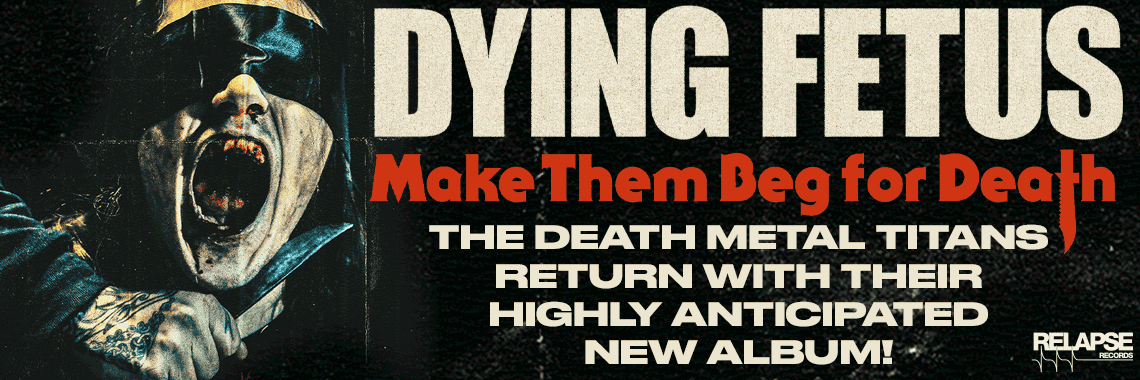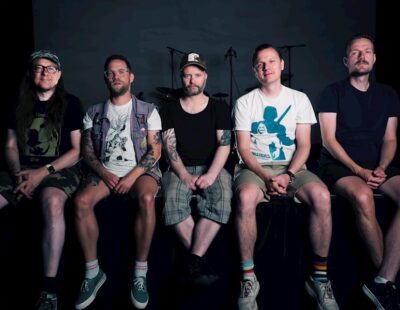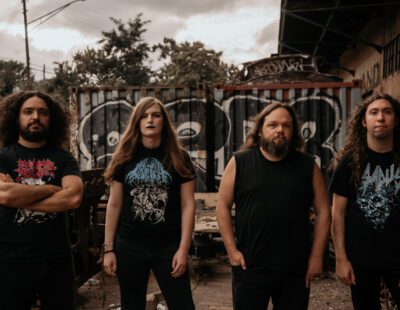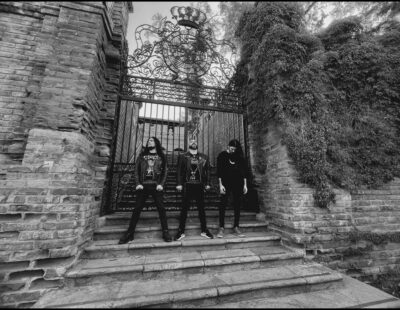A couple of weeks ago we told you that UK writer Dayal Patterson had finished off a 600-page history of black metal, Black Metal: Evolution of the Cult, a book that aimed to peel the corpsepaint off black metal’s sensationalist public image and look at how it started and how it got to where it is today. Evolution of the Cult is now available for pre-order here at a discounted price. Well here’s author Dayal on what it’s like trying to piece together the scene’s chaotic history without sexing up the controversy and focusing on the music.
Firstly, here’s something to set the mood . . .
When did you start the book, and what was the goal from the outset?
I guess it started about September 2009. I guess I got to the point where I had seen a lot of films and documentaries and articles coming out from non-black metal media and I kind of felt that they were selling it a bit short, and I felt that I was waiting through the years for someone else to do a book and thinking that somebody would release one at any moment, and then I kind of came to the conclusion that I should probably do something. But it seemed like a huge task; there’s about 30 years of history there. But I went to Bergen for Hole in the Sky that year. I think I had already spoken to Roger [Tiegs], Infernus from Gorgoroth, about visiting his place. It seemed like a good opportunity and there were a few people that I wanted to speak to there. I guess that was the catalyst. And I had arranged to meet with Necrobutcher and Manheim, who are the two surviving members of the original Mayhem lineup. That was in Oslo; I went to Bergen for Hole In The Sky and traveled to stay with some friends in Oslo, so quite a lot was done in quite a short time, and I guess it expanded from there.
What did you personally feel was missing from black metal’s history, that couldn’t be found from, say, Lords of Chaos, or documentaries like Where the Light Takes Us?
Well Lords of Chaos, that’s an interesting book, but I think that was written in ’97 or ’98, so there’s been almost a decade and a half of activity since then, and also that wasn’t particularly about the music, it was more about the interesting themes around, say, Satanic metal or extreme metal; and a lot of films, like the one you mentioned, give a lot of insight into into certain characters but not many of them. I think one of the things I really wanted to do with this book was try and make it as complete an overview as possible, and to include a lot of the stuff that usually gets left out. I really wanted to give a much more detailed view of how this genre has come about and the different directions it has branched off in, and I wanted to balance that off with it being really in-depth when it came to the interviews, getting much more detail. I’ve been reading black metal interviews since ’95/’96, so I know much of the anecdotes that have been told before, so I know if what someone’s telling me is new information. That’s what I really wanted, something that would give a really accurate look at how it all happened and how the genre had evolved but make sure, that even for someone who has been in black metal for a while they could read and it’d still give a lot of new information, and lots of new insight. And I really think there is that, because a lot of the stuff that people have said to me, a lot of them said that they’ve never told anyone this before. It’s the same with the photos; there are some exclusive photos in there and I really wanted it to be as much for the person who knew nothing about black metal as it did to someone who has been following the scene for a long time.
How did you approach the material that was a bit more familiar, the anecdotes we have heard before; how did you tackle them but still keep it fresh?
Obviously you have to cover some of it, but I didn’t want it to be a sensationalist book that focused too much on the church burnings and the murders and so on but I didn’t want to skip that over, so you have to talk about those things. But I have definitely tried to do it from the perspectives of the people involved, so the chapters about that Norwegian saga features voices of a lot of the main protagonists from that period, and how they viewed it, how they remembered it rather than being from too historical or too removed. So yeah, it was just to get those personal insights, and also I think there is the benefit of hindsight because, in that whole saga, you’ve got people like Fenriz and Necrobutcher, the guys from Enslaved, Samoth, Hades, and people that were really involved then, and they kind of had a bit more space to get a bit more perspective on things. I tried not to focus too much on that stuff. But I tried to focus on how people were affected by those events and not just what had happened.
https://youtu.be/ZuaoUul87oM
Has doing this book changed your perspective of black metal?
Yeah, I think it did. One thing that really changed was, when I started writing the book I was thinking about black metal, a lot of documentaries and films, and they want to start black metal’s story around ’91/’92 when it was erected in Scandinavia, so you find that there are only a few pages given to the bands who were in the ’80s, and although I was already a massive Bathory and Celtic Frost fan, I think I was pleasantly surprised at how much of the book ended up being about the First Wave. So there were a lot of bands, like Venom, Hellhammer and Bathory, but also Rotting Christ, Samael, Masters Hammer especially, who preceded a lot of that. I think Fenriz described them as, “They were Norwegian black metal before Norwegian black metal.” I think there were a lot of people who were misguided into thinking that black metal was born in Norway. It was definitely resurrected there but I was made aware through doing the interviews and writing of how much had come before that, and also, before every chapter, I had people talking about whatever band was in question, so the chapter on Venom, for example, I’ve got people giving a little bit of an introduction on what that band meant to them, from bands like Samael and Mayhem and so on. I really tried to create a link between how each band influenced another one, and what people took from that. The title is fairly important because I guess it is really about the evolution of it as well as how one thing has led to another, and I think it has done a pretty good job of showing how black metal did go from Venom in 1980 or 1979 to Wolves in the Throne Room, or whatever band people are looking at now. Or even Fen . . . It’s just that complete evolution, and just how many faces that it’s been given. You’ve still got that diehard underground black metal scene in Poland and Ukraine, and you’ve got a commercial face, and you’ve got a political face . . . There are so many faces to it; I didn’t want it to be one dimensional.
How did you tackle the politics? Did you cover NSBM and, if so, did you get much cooperation from them?
There’s a big chapter, maybe the biggest chapter of the book is on the politics of black metal. I spoke quite extensively to Rob Darken from Graveland (and the many other bands that he was in during the ’90s) and he was quite open. His views are pretty politically incorrect, if you like, so I kind of had him representing that side of it as well as people like Mortiis from Emperor, and Watain. I think even Necrobutcher talks about it, and Fenriz, and Marduk. I wanted to give it its due. I wanted to examine it. The main thing I was looking at was how it went from this early ’90s scene where most of the bands were dabbling in right-wing politics – most of the bands in Scandinavia were – and how that became this whole movement in eastern Europe. So there’ s a whole chapter on eastern European black metal and Polish black metal. You’ve got bands like Infernum and Graveland, and a look at really how strong that scene was and the history of it. Rob was very useful for that; it’s probably a bit much to state it like this, but he was probably the Euronymous of the NSBM scene in Poland. He was a very central figure. I just tried to present it without any judgment, or to try censor it. One of the problems when mainstream magazines cover it, is a lot of them don’t want to talk about the less comfortable things so they just don’t mention it. A lot of mainstream metal magazines would rather not touch upon the politics. I always think it’s best to respect the reader enough to make their own opinions.
What was the most difficult aspect of putting a 600-page book on black metal together.
There were quite a few difficulties; obviously, there was no money involved and it’s a big book, it’s a lot bigger than your normal music book, so it took quite a lot of time, and I couldn’t be doing freelance work during some of that. And I didn’t have a publisher until quite late on. So part of it was organising it and keeping it on track, and the other hard part was trying to get through to some of these people, because black metal musicians generally aren’t the most organised people. And a lot of people were doing this before the Internet, so finding photos from before the digital era was difficult. Bands like Gorgoroth don’t have any of their own images before 2002/03, so in that sense it was difficult getting pictures of the band. I had to fight a little bit with the publisher to extend the word count because there was just so much in there, and I guess just trying to find a cohesive time line was quite hard as well.
Where do you see the most growth and evolution in the black metal scene now?
Right now? I think it’s hard to pinpoint one aspect of the scene but I think one of the reasons that black metal is so interesting is that it remains very conservative and very liberal, artistically speaking, at the same time. You’ve always got these new strands coming through, whether it’s industrial black metal bands like Black Lodge or post-BM bands like Fen, you’ve always got this very open-minded and free aspect of black metal but you always have this very resolutely traditional and conservative values; you’ll have a band that’s probably formed in the last few weeks that will be playing like Blasphemy or some band from the ’80s. Or there’ll be another band creating that early Burzum vibe. I think that is the most interesting thing. In a lot of scenes it becomes very one sided, about pushing the boundaries and being contemporary but it’s not so much like that with black metal. A lot of people in black metal would like to tell you that this is black metal or this isn’t black metal but it is such a wide genre, much wider than lots of musical genres, much wider than lots of genres of metal.
**Like Black Metal: Evolution of the Cult on Facebook**






